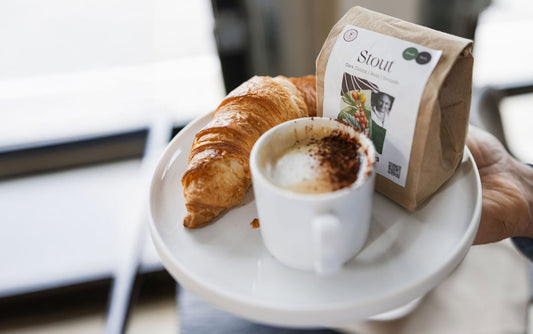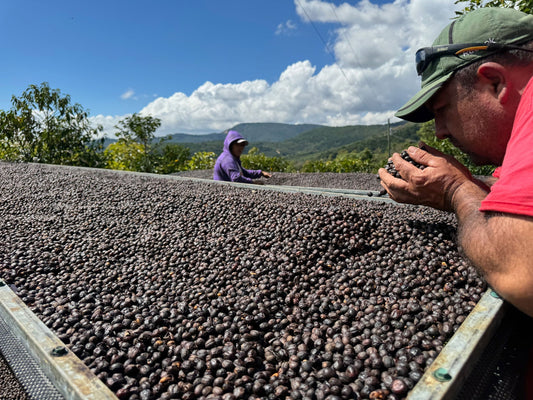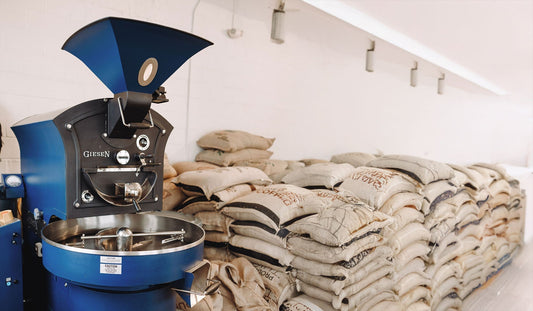It is not a gimmick. It is a set of choices grounded in agronomy, processing, roast chemistry, and brew science.

Below, we will break down what makes it work, then give you drink ideas that keep the same stoutlike character whether you drink milk, drink black, or drink cold.
No fluff, no fairy tales. Just what is in the cup and why it tastes the way it does.
|
TL;DR Medium to medium plus roasted Brazilian coffee beans, grown in 100% volcanic soil, give chocolate and nutty flavor with gentle dark-fruit and very low acidity, especially from natural or pulped natural lots. |
What We Mean By Brazilian Stout
Brazil dominates the global arabica market, which matters because supply shapes what most people drink.

Brazil’s farms grow workhorse varieties that thrive in the country’s climate and farming systems, creating a dependable foundation for chocolate and nut leaning profiles.
Varieties That Keep Sweetness And Balance
Catuai and Mundo Novo are common, productive varieties in Brazil. Handled well, they deliver dependable sweetness with moderate acidity, which is exactly the baseline a stoutlike cup needs. Catuai was released in Brazil in 1972 and remains widely cultivated.
Processing That Favors Chocolate Over Sharp Acid
Naturals and pulped naturals are common due to long dry seasons.
More mucilage contact during drying nudges flavor toward chocolate and nuts, adds body, and lowers perceived brightness compared with many washed East African coffees.
This is the outcome of climate, cultivar, and processing choices that Brazil scaled better than anyone.
Roast Goals For A Stoutlike Cup
When we roast a Brazilian lot for our Stout profile, we are not aiming for burnt or ashy.
We target a development window that maximizes chocolate compounds and nut aromas, tames sharp acids into pleasant structure, and preserves enough volatile aromatics to keep the cup from tasting flat.
Where It Shines In Espresso And Milk
Think cocoa, pecan, caramelized sugar, and a clean finish.
Those targets align with how a lot of Brazil specialty coffee is used in espresso blends for body and sweetness, and why it performs so well as a stand alone espresso or milk drink.
If you want the flavor I’m describing in your cup, start with our Stout – Brazil.
It’s a single-origin lot from a 1000 hectare estate near Angelândia in Minas Gerais, grown in cool tropical conditions and mineral rich soils.
Expect dark chocolate, roasted nut sweetness, and a smooth finish that holds up as espresso, with milk, or over ice.
Brazilian naturals and pulped-naturals are common in espresso blends for body and chocolate sweetness.
The Science Behind The Flavor Profile
Varieties And Processing Common In Brazil
Mundo Novo, a natural cross between Bourbon and Typica, has a long history in Brazilian production. These two are everywhere in Brazil and can deliver dependable sweetness with moderate acidity when processed well.
That baseline is a cornerstone of why a stoutlike cup is repeatable year after year.
Processing That Favors Chocolate And Body
Processing matters as much as variety.
Brazil’s widespread use of natural and pulped natural methods leaves more mucilage contact during drying, pushing the cup toward chocolate and nut notes, heavier body, and slightly lower perceived acidity than washed counterparts from other origins.
Again, this is not universal, but it is a strong tendency in Brazilian lots handled this way.
Roast Development And Perceived Acidity
How Roast Chemistry Changes Acidity
Coffee carries several organic acids in green form.
During roasting, chlorogenic acids break down into lactones and related compounds, shifting perception from sharp fruit toward caramelized sweetness and cocoa.
Roast degree and development time change how acidity is experienced, even when pH alone does not explain it.
Why Medium To Medium Plus Hits The Sweet Spot
For a stout-like cup, aim for medium to medium plus development.
This keeps aromatics alive while transforming acids into a rounder, chocolate-forward profile. It is the lane where cocoa and nut notes pop and perceived acidity stays comfortable for most palates.
Brew Temperature And Perceived Sweetness
Cold extraction changes extraction dynamics, which is why cold brew and nitro cold brew taste smoother and less sharp to most people.
Controlled studies show cold brewed coffee tends to have lower titratable acidity and slightly higher pH compared with hot brews of the same coffee, which translates to less perceived sourness.
That helps the stoutlike character land, especially with chocolate-forward Brazils.
How We Roast And Source For Consistency
We cup to a standard.
The SCA cupping framework and flavor wheel give us shared language. We measure acidity intensity, sweetness, body, and aftertaste, and we log how changes in roast development nudge each trait.
The goal is not to chase scores. It is to build a repeatable profile that survives real-world brewing from home grinders to busy cafe bars.
Our sourcing priorities are simple.
We look for lots with clean cups, chocolate-forward aromatics, and enough underlying character that the coffee does not collapse when you pull a tighter espresso or steep a longer cold brew.
Naturals and pulped naturals from farms with tight drying control tend to land here most reliably. That lets us promise a style without turning it into a caricature.
Brewing Recipes That Make It Shine
Everyone’s grinder and water are different, so take these as starting points.
Adjust grind and contact time to taste. If your shots run sour, grind finer or extend the ratio slightly. If they run bitter and hollow, coarsen a notch or reduce contact time.
Espresso For Straight Shots
Dose 18 grams. Aim for 36 to 40 grams out in about 28 to 33 seconds from pump on.
Preinfuse only if your machine repeats it consistently. This ratio keeps chocolate and caramel in focus while keeping the finish clean.

If your shot tastes sharp, coarsen half a notch and raise yield to 42 grams to open the cup. If it tastes heavy and dull, grind finer and pull it shorter.
Espresso For Milk Drinks
Dose 18 grams. Aim for 30 to 34 grams out in 27 to 31 seconds.

This tighter ratio gives you syrupy texture and enough intensity to cut through milk without turning bitter. Steam to a glossy microfoam and pour small.
You should taste cocoa, toasted nuts, and a gentle caramel sweetness that does not disappear in milk.
Filter Brew For Everyday Mugs
Use a flat-bottom dripper or a well-designed conical.
Start at 1 to 15. For a 300 gram brew, grind medium and finish your pour by two minutes, with total brew around three minutes.

You are looking for a balanced cup with chocolate leading, nut supporting, and a mild dried fruit accent. If you taste papery or muted notes, rinse your filter thoroughly and tighten your grind slightly.
Cold Brew For Stoutlike Iced Coffee
Coarsen your grind. Use a 1 to 10 ratio and steep 12 hours in the fridge.
Filter thoroughly. To serve, dilute the concentrate to taste. Expect lower perceived acidity and rounded chocolate sweetness, which is consistent with what controlled studies have found when comparing cold and hot extractions.

Keep it refrigerated and consume within a couple of days. Cold brew is slightly acidic but not acidic enough to prevent microbial growth, so do not treat it like a shelf stable beverage.
Nitro Style Texture Without A Keg
If you do not have a nitrogen setup, you can still chase texture.
Brew a strong cold concentrate, chill it hard, then hard shake it in a safe, well-sealed shaker with a couple of clean ice cubes.

Pour immediately into a chilled glass to keep the microbubbles alive. True nitrogen infusion produces a distinct cascade and a velvety mouthfeel that most people describe as sweeter and less bitter.
That is a cafe tool, but the principle is the same. You are smoothing edges with gas and serving colder.
Five Drinks That Keep The Stout Character
These are not sugar bombs. They are built to let Brazil’s chocolate and nut notes carry the glass.
Iced Brazilian Stout Highball
Brew a strong cold concentrate. Fill a tall glass with large ice.
Add sixty milliliters of concentrate and two hundred milliliters of chilled still mineral water. Express an orange peel over the top and discard it. The citrus oil lifts aroma without turning the cup into a creamsicle.
Cocoa Cream Iced Latte
Pull a thirty two gram espresso from an eighteen gram dose.
Stir in a teaspoon of unsweetened cocoa powder until dissolved. Add over ice and top with one hundred fifty milliliters of cold whole milk or your preferred alternative.
Chocolate stacks on chocolate and the milk softens any leftover bite.
No Alcohol Espresso Stout
Chill a six ounce glass in the freezer.
Pull a short, syrupy shot and pour it over an equal measure of cold brew concentrate. Add three drops of vanilla extract and a splash of chilled water.
Hard shake in a sealed shaker with one cube and strain into the chilled glass. The combination mimics the mouthfeel and head of a stout without any actual fermentation.
Brazilian Stout Tonic
Build over ice. Two parts chilled cold brew concentrate to three parts chilled tonic water.
Stir gently once. Add a lemon twist. The quinine and sugar in tonic snap the chocolate notes into focus and the bubbles add lift. If it reads too sweet, use a dry tonic or top with a splash of soda.
Affogato With Cold Brew Cubes
Freeze cold brew into cubes.
Add two or three cubes to a small bowl and pour a fresh double shot over vanilla gelato. As the cubes melt, you get a rolling sweetness that lengthens the finish without making the cup taste thin.
Why Brazilian Stout Plays So Well With Milk
Milk proteins bind with certain bitter compounds and soften perception.
That is why a chocolate forward espresso reads like melted candy with microfoam. Brazils processed as naturals and pulped naturals tend to have more body and caramelized sugars, which means they hold shape when you add milk instead of vanishing into it.
Your cappuccino will not taste like a sad latte with a tan top. It will taste like a dessert you did not sweeten.
A Few Honest Notes On “Low Acidity” Claims
You will see a lot of hand waving about acidity.
Here is the short version. Perceived sourness is influenced by roast level, extraction temperature, and brew strength, not just pH.
Cold brews typically measure slightly less acidic and taste smoother, but some of the most interesting coffees in the world are lively and bright.
The point of our Brazilian Stout is not to erase acidity. It is to shape it so the chocolate and nut core leads and the finish stays clean. Studies consistently show cold brews trend higher in pH and lower in titratable acidity compared to hot brews, and that roast degree meaningfully alters acid composition.
That is the real background behind the “gentle on the palate” story you often hear.
Frequently Asked Questions
What Makes Brazilian Stout Different From A Traditional Dark Roast?
It targets chocolate and nut sweetness without tipping into ash. Roast development is pushed only far enough to round acidity and amplify cocoa compounds while preserving origin character.
Which Brazilian Regions Most Often Deliver This Chocolate And Nut Profile?
Cerrado Mineiro, Sul De Minas, Mogiana, and parts of Chapada Diamantina frequently yield lots with balanced acidity, medium body, and cocoa, caramel, and nut notes. Microclimate and processing still shape the final cup.
How Long Should I Rest The Beans After Roast Before Brewing?
For filter, five to twenty five days off roast is a reliable window. For espresso, seven to thirty five days works well. If shots taste sharp or gassy, wait a few more days. If the cup tastes flat, you may be past peak or under extracting.
Is There A Decaf Option With A Similar Flavor?
Look for sugarcane ethyl acetate decaf from Brazil. Sugarcane ethyl acetate decaffeination often yields balanced, chocolatey, sweet cups.
Conclusion
Brazilian Stout works because it is honest about what Brazil does best.
Productive varieties, climate that supports naturals and pulped naturals, and a roast that favors cocoa and caramel without burying origin.
The result is a cup most people actually want to drink, not just talk about.
If you like chocolate and nuts with gentle fruit and a calm finish, this is your lane. It holds the shape of espresso, it stays clear in milk, and it reads smooth over ice.
You do not have to chase a fragile light roast to prove you care about quality. You just have to extract what the green already gives you.
If you want help dialing it in, tell me your grinder, water, and preferred serve. I will give you a starting point that fits your setup, not a lab fantasy.
Then brew it, taste it, and adjust. Good coffee is built, not wished for.





